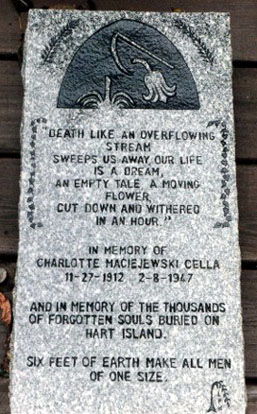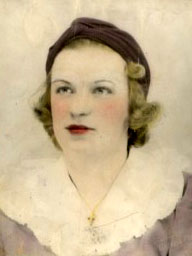Hart Island, at the western end of Long Island Sound, is the resting place of more than 750,000 people, most of them forgotten, in the nation’s largest potter’s field. One of them is my Aunt Lottie. She isn’t forgotten, but she has no monument except for the one that serves for all. Aunt Lottie, known more formally as Charlotte Maciejewski Cella, died in 1947, before I was born. My mother’s memories are all I have to reconstruct the existence of a person who helped shape who I am today. My grandmother, Hedwig Maciejewski, came to the United States from Poland in 1912 with three small children. The youngest, Charlotte, was just a newborn. My grandfather preceded Grandma and had settled in Forest City, a coal-mining town in northeast Pennsylvania. Long hours in the mines working for low wages left little extra to build the dream that brought the Maciejewskis to America. Remembering the gardens in her native Poland, my grandmother became disillusioned. She refused to learn English and longed for her distant home. The family had grown to nine children and work in Forest City offered no prospects for Lottie. She longed for a better life, and when the opportunity came to move north to Binghamton, New York, to work in a cigar factory, she leapt at it. There she met Charlie Cella and soon brought this new beau to visit her family. Wanting to share her excitement, she helped her brothers and sisters make a celebratory cake, forcing grandma to re-think the week’s menu since all the eggs disappeared in the batter. Aunt Lottie was happy and vibrant; Grandma and Grandpa were shocked by her short haircut and her flapper dress, but Lottie and Charlie were on top of the world. Lottie kept her younger brother and sisters spellbound with stories of life away from the daily struggle of a mining town. Charlie and Lottie were married in Binghamton in 1937 and wanted to raise a family. I don’t know the details of why they didn’t have children of their own, but they were able to initiate adoption procedures for a 4-year-old girl. Life was good for Aunt Lottie: a good husband, steady income and a beautiful, spirited child who would soon be her own daughter. Visits to Forest City were happy times: Lottie’s dreams were coming true, and her brothers and sisters were inspired to look beyond their coal town.
Uncle Charlie and Aunt Lottie never adopted the little girl. The girl’s biological mother changed her mind. Charlie and Lottie decided to leave behind their crushed dreams and start anew in New York City, where opportunity was on every street corner. But reality changed the path to their dreams. Contact with her family in Forest City happened less often because of distance expense and embarrassment of failure. Charlie and Lottie drifted apart and were divorced. When he was 36, Charlie was drafted into the Army during World War II. He was killed in action in France on the last day of the war. Lottie stayed in Manhattan and worked as a waitress. She never went back to her family because of the shame of her divorce. Aunt Lottie became ill. At the beginning of her illness, my mother went to New York to help care for her and gave her a bus ticket to Binghamton. But pride kept Aunt Lottie from using it. More than six months later, she died alone at Roosevelt Hospital on Feb. 8, 1947, at age 34. The hospital sent two telegrams to grandma, one telling her of Lottie’s death, the other asking for permission to perform an autopsy. My grandmother never learned English, and since she had no idea what the telegrams contained, she set them aside for someone to translate. They were discovered months later, long after Aunt Lottie’s unclaimed body was sent for burial at Hart Island. She was interred in an unmarked grave on February 27, 1947. Aunt Lottie was not a forgotten or indigent person. She was buried on Hart Island because of an odd set of circumstances. Copyright© 1999 by The New York Times Co.[as to main text] Reprinted by permission |

